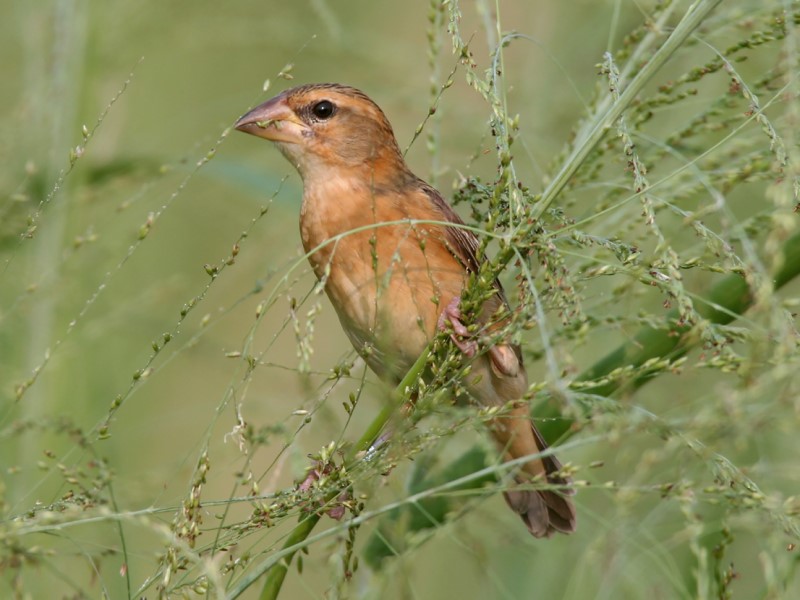Baya Weaver Ploceus philippinus 黃胸織雀
Category IIC. Previously there was a local and irregular resident breeding population of captive origin based at Mai Po; however, not recorded since 2004.
IDENTIFICATION
15 cm. Similar in structure to munias, but bulkier with a larger but more tapered bill. The male has yellow forehead and crown contrasting with dark brown face and throat, dark brown mantle and back feathers fringed buff, plainer, yellowish rump and yellowish chest.

Oct. 2003, Michelle and Peter Wong.
The female and non-breeding male have dark brown upperparts with pale fringes, whitish throat, buff underparts that are richer across the chest and have indistinct streaks on the upper chest. The presence of a broad pale supercilium of equal emphasis before and behind the eye imparts a facial appearance similar to that of female House Sparrow.
VOCALISATIONS
The song is a series of chattering notes followed by a whistled and wheezy notes.
The call is a sparrow-like ‘chit’ though louder and stronger.
DISTRIBUTION & HABITAT PREFERENCE
Most records came from Mai Po NR, where birds nested from 1995 to 2003. Other records came from open-country areas in the northwest New Territories, mainly in fish pond areas close to Mai Po indicating there was only one population.
OCCURRENCE
Baya Weaver was first recorded on 22 August 1970 at Sandy Bay where an obvious release of up to 30 birds had taken place. On 29 September in the same year a flock of ten were seen at Ping Shan, and on 6 May 1978 a male was seen at Mai Po. A male at Mai Po on 17 September 1983 was followed on 12 October 1985 by the trapping of two juveniles there. Further juveniles were trapped there on 26 September and 3 October 1987 during a period when at least five female or immatures believed to be of this species were present at Mai Po. An immature found moribund in an illegal bird-net at Ma Tso Lung in January 1988 was, based on comparison with skins at the British Museum, probably of the subspecies burmanicus, whose native range is northeast India, Bangladesh and Burma, extending into southwest China.
Apart from a male at Mai Po on 7 May 1989, there were no further records until 12 May 1993, which marked the beginning of a prolonged period of presence in the Mai Po area until April 2004, though there were only five reports after October 2001. Birds were seen (though not necessarily reported) regularly at Mai Po with the highest count being 50 on 17 October 1995, the year in which most reports were received. Also, in 1995 breeding was confirmed for the first time, with eight nests found in two separate colonies at Mai Po; breeding continued in at least one colony through to summer 1997. An adult male caught that year proved once again to be of the subspecies burmanicus.
Over the course of the period, Baya Weaver was reported from 26 February to 9 December, though largely in the wet season months of March to October.
Thus, Baya Weaver was a breeding species in HK. However, as a resident species whose nearest known area of natural occurrence is Yunnan, southwest China, and of which large-scale releases are known to occur, it is extremely unlikely that it reached HK unaided. As a result of its being ex-captive but no longer established as a breeding species, it is placed in Category IIC of the HK List.
BREEDING
Nesting colonies of up to five nests were first noted in 1995 in Casuarina equisetifolia trees mainly along the main entrance path to Mai Po NR and in trees at the edge of an abandoned fish pond near the car park, though a single nest was seen near the helipad near Lut Chau in 1996. Breeding continued until 2003, when five nests were noted, while in 2004 only one unfinished nest was reported.
BEHAVIOUR, FORAGING & DIET
Seen foraging on seeds of grass and reeds.
RANGE & SYSTEMATICS
Resident in much of India, as well as Pakistan, northern Sri Lanka, Myanmar, Thailand, Indochina and Malaysia to Sumatra and Java (Craig 2020). Five subspecies recognised, with that occurring closest being P. p. burmanicus, which is present in Yunnan and is considered to occur in HK.
CONSERVATION STATUS
IUCN: Least Concern. Population trend stable.
Craig, A. J. F. (2020). Baya Weaver (Ploceus philippinus), version 1.0. In Birds of the World (J. del Hoyo, A. Elliott, J. Sargatal, D. A. Christie, and E. de Juana, Editors). Cornell Lab of Ornithology, Ithaca, NY, USA. https://doi.org/10.2173/bow.baywea1.01

